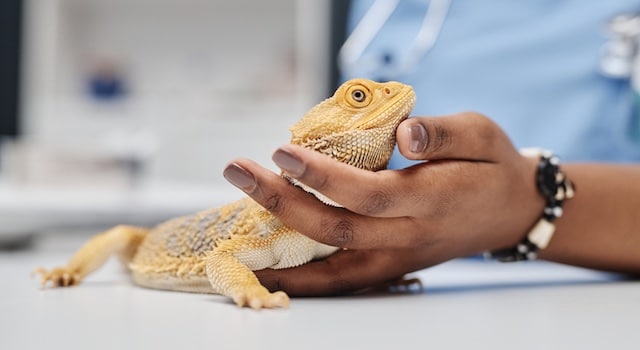
Introduction to Bearded Dragon Yellow Fungus
Bearded dragon yellow fungus is a common yet life-threatening fungal disease caused by fungi in the genus Nannizziopsis. Yellow fungus can also affect many other types of captive reptiles. As the name suggests, it causes distinct yellow lesions or skin discoloration, which can sometimes appear brown or gray. Yellow fungus disease is very difficult to treat, and a cure has not been discovered yet. This makes it important for bearded dragon owners to be aware of this disease and how it can be prevented.
What causes bearded dragon yellow fungus disease, how is it treated, and what symptoms should you look out for? This article will tell you everything you need to know.
Causes of Bearded Dragon Yellow Fungus
The main cause of yellow fungus in bearded dragons is Nannizziopsis guarroi, a species of fungi in the family Onygenaceae. It was originally believed to be caused by fungi in the genus Chrysosporium, specifically C. anamorph of Nannizziopsis vriesii (CANV). However, researchers found that the fungi actually belonged to a distinct lineage and reclassified them into the genus Nannizziopsis. Both genera are closely related because they belong to the same family and are known to cause skin infections in reptiles.
Researchers are unsure about how exactly bearded dragons get yellow fungus disease, but it’s primarily believed to be caused by inadequate husbandry and diet. Environmental stressors, such as the wrong temperature and humidity levels or a lack of UVB lighting, could make a bearded dragon more susceptible to the infection. This is because improper care and diets can weaken a bearded dragon’s immune system and make it difficult for their body to fight off infections. Open wounds or abrasions caused by injuries or shedding issues also put your bearded dragon at risk of being infected with yellow fungus.
Symptoms of Bearded Dragons Yellow Fungus
- Yellow to brown lesions or skin discoloration
- Powdery, rough patches on the skin
- Lethargy
- Shedding issues (excessive or incomplete shedding)
- Lack of appetite and weight loss
- Systemic infection leading to organ damage
The first signs of yellow fungus are mostly external but can progress to deeper tissues or internal organs in severe cases. It can take a few days to weeks before you start to notice signs of this disease. Generally, the first signs are often small yellow to brown lesions on the scales that spread and darken over time.
The lesions have a powdery appearance, which can make the infected skin appear discolored or patchy. In severe cases, the lesions can lead to secondary infections and necrosis (dead tissue). The scales along the infected area can start falling off, exposing red or purple flesh underneath. The infection usually appears around open wounds or infected areas, often along a bearded dragon’s stomach and mouth or the underside of their head or tail. But it can still affect any part of their body.
It’s difficult to spot yellow fungus lesions on tan or yellow bearded dragon morphs because they blend in. This makes it important to pay attention to their behavior and any changes in their skin coloration, such as dark patches.
Aside from external symptoms, bearded dragons will also experience changes in appetite and activity levels. Yellow fungus is painful and uncomfortable, so bearded dragons won’t be interested in eating or doing their usual activities like basking or exploring. They may also act lethargic and weak.
How is Bearded Dragon Yellow Fungus Diagnosed?
You should take your bearded dragon to a veterinarian immediately if you notice any skin abnormalities, even if you aren’t sure what’s causing it. This includes any lesions, burns, abrasions, or skin discoloration.
Only a qualified reptile veterinarian can accurately diagnose yellow fungus in bearded dragons. It’s usually diagnosed with a skin biopsy rather than a physical exam alone. Yellow fungus lesions look very similar to other bacterial and fungal infections or even burns or scrapes. A skin biopsy helps veterinarians determine the exact cause of your bearded dragon’s symptoms and to rule out other possibilities. The veterinarian is also likely to test for secondary infections and take bacterial or fungal cultures to confirm yellow fungus or another infection.
Treatment Options for Bearded Dragon Yellow Fungus
Whether or not yellow fungus is curable is widely debated within the reptile community. Although there is no definite cure, there are several treatment options. Treatment usually involves topical antifungal creams applied to the affected areas, such as ketoconazole, voriconazole, terbinafine, and itraconazole. Topical medications are applied once to twice daily after a bath onto clean, dry skin. Oral medications like voriconazole are used to treat serious fungal infections. Topical and oral medications are typically used in addition to amputation or the removal of infected tissues in severe cases.
As with most health issues, yellow fungus is easier to treat in the early stages. Not all beardies make a successful recovery if the infection progresses to deeper tissue or organ damage. Yellow fungus can take weeks to months to treat, and sometimes multiple treatments need to be used, especially if your bearded dragon isn’t responding well to one of the medications.
Prognosis and Long-Term Care
As you’ve probably already gathered from this article, yellow fungus is a very serious disease that requires intensive treatment. Your bearded dragon may still need long-term care and if they receive proper treatment and most of their symptoms have cleared up.
The veterinarian who is treating your bearded dragon will help you develop a long-term care plan based on their symptoms and the severity of the infection. This usually involves regular health checks to monitor their symptoms and treatment effectiveness. You may also need to make changes to their enclosure according to the veterinarian’s recommendations, such as upgrading the enclosure or providing proper lighting and heat.
It’s important to know that yellow fungus is contagious between bearded dragons and other reptiles. You should implement very strict hygiene practices when handling other reptiles, whether it’s their enclosure, food, or supplies. Avoid sharing food and water bowls, feeding tongs, travel carriers, and any other supplies between your reptiles. It’s also a good idea to keep your infected bearded dragon in a different room from your other reptiles.
Preventing Bearded Dragon Yellow Fungus
Stress and a weakened immune system increase your bearded dragon’s likelihood of being infected with yellow fungus. You can strengthen your bearded dragon’s immune system and reduce stress by caring for them properly and feeding them a healthy diet.
Bearded dragons need a spacious enclosure with a proper UVB light and a basking lamp for warmth. Their enclosure should be cleaned regularly to prevent waste buildup and to maintain a hygienic environment. Although it’s good to use substrates that retain moisture well to raise the humidity levels, keeping the enclosure too damp creates an ideal environment for fungi to grow.
Furthermore, a healthy diet that contains all the essential nutrients a bearded dragon needs helps to strengthen their immune system. Vitamin and mineral deficiencies can lead to all sorts of health issues aside from just a weak immune system, so make sure that their diet is balanced and contains appropriate supplements.
Since open wounds or abrasions are at risk of being infected, you should keep them clean and have them treated by a veterinarian to prevent infection. Try to protect your bearded dragon from becoming injured in the first place by removing any sharp or rough items in their enclosure and preventing falls from tall platforms.
Conclusion
You should take your bearded dragon to a veterinarian right away if you notice any yellow or dark lesions on its body. Yellow fungus can be serious if left untreated, so early treatment and prevention give your beardie a better chance of recovery. You can protect your bearded dragon against yellow fungus disease by caring for them properly, feeding them a healthy diet, and keeping wounds clean to minimize infection.



